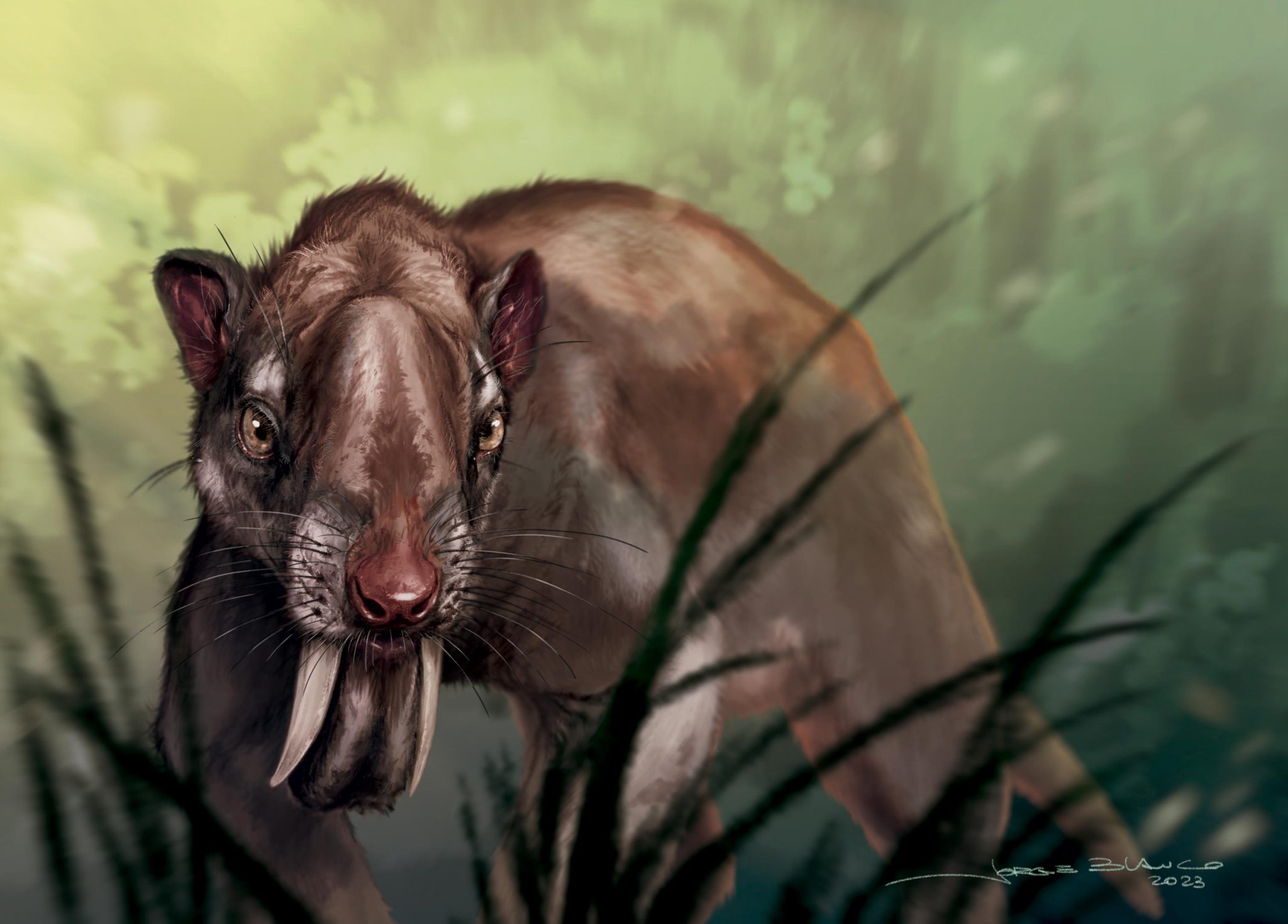
Rekonstytucja Thylacosmylus atrax. Źródło: © Jorge Blanco
Jak „torbacz szablozębny” Thylacosmilus widział swój świat
Badanie opisuje, w jaki sposób wymarły hipermięsożerca, pomimo szeroko rozstawionych oczu, osiągnął widzenie 3D bardziej charakterystyczne dla roślinożerców niż drapieżników.
Nowe badanie bada, w jaki sposób wymarły, mięsożerny krewny torbacza z kłami, które rozciągają się na czubku czaszki, mógł skutecznie polować, mimo że miał oczy tak szerokie jak krowa lub koń. Czaszki mięsożerców mają zwykle skierowane do przodu oczodoły lub oczodoły, które umożliwiają widzenie stereoskopowe (3D), co jest przydatną adaptacją do oceny pozycji ofiary przed skokiem. Naukowcy z Amerykańskiego Muzeum Historii Naturalnej i Glaciologii oraz Ciencias Ambientales Instituto Argentino de Nivologia w Mendoza w Argentynie badali „torbacza szablozębnego”. Thylacosmilus atrax Widziane w 3D. Ich wyniki opublikowano dzisiaj (21 marca) w czasopiśmie Biologia komunikacji.
Popularnie znany jako „ torbacz szablozębny (lub metatherian) szablozębny”, ponieważ jego niezwykle duże górne kły przypominają bardziej znaną szablozębną łożyskową, która pochodzi z Ameryki Północnej. Thylacosmilus Żył w Ameryce Południowej aż do wyginięcia około 3 milionów lat temu. Był członkiem Sparasodonta, grupy wysoce mięsożernych ssaków spokrewnionych z żywymi torbaczami.
Chociaż sparasodont[{” attribute=””>species differed considerably in size—Thylacosmilus may have weighed as much as 100 kilograms (220 pounds)—the great majority resembled placental carnivores like cats and dogs in having forward-facing eyes and, presumably, full 3D vision. By contrast, the orbits of Thylacosmilus, a supposed hypercarnivore—an animal with a diet estimated to consist of at least 70 percent meat—were positioned like those of an ungulate, with orbits that face mostly laterally. In this situation, the visual fields do not overlap sufficiently for the brain to integrate them in 3D.
Why would a hypercarnivore evolve such a peculiar adaptation? A team of researchers from Argentina and the United States set out to look for an explanation.

A reconstruction of the skull of Thylacosmilus atrox. Credit: © Jorge Blanco
“You can’t understand cranial organization in Thylacosmilus without first confronting those enormous canines,” said lead author Charlène Gaillard, a Ph.D. student in the Instituto Argentino de Nivología, Glaciología, y Ciencias Ambientales (INAGLIA). “They weren’t just large; they were ever-growing, to such an extent that the roots of the canines continued over the tops of their skulls. This had consequences, one of which was that no room was available for the orbits in the usual carnivore position on the front of the face.”
Gaillard used CT scanning and 3D virtual reconstructions to assess orbital organization in a number of fossil and modern mammals. She was able to determine how the visual system of Thylacosmilus would have compared to those in other carnivores or other mammals in general. Although low orbital convergence occurs in some modern carnivores, Thylacosmilus was extreme in this regard: it had an orbital convergence value as low as 35 degrees, compared to that of a typical predator, like a cat, at around 65 degrees.
However, good stereoscopic vision also relies on the degree of frontation, which is a measure of how the eyeballs are situated within the orbits. “Thylacosmilus was able to compensate for having its eyes on the side of its head by sticking its orbits out somewhat and orienting them almost vertically, to increase visual field overlap as much as possible,” said co-author Analia M. Forasiepi, also in INAGLIA and a researcher in CONICET, the Argentinian science and research agency. “Even though its orbits were not favorably positioned for 3D vision, it could achieve about 70 percent of visual field overlap—evidently, enough to make it a successful active predator.”
“Compensation appears to be the key to understanding how the skull of Thylacosmilus was put together,” said study co-author Ross D. E. MacPhee, a senior curator at the American Museum of Natural History. “In effect, the growth pattern of the canines during early cranial development would have displaced the orbits away from the front of the face, producing the result we see in adult skulls. The odd orientation of the orbits in Thylacosmilus actually represents a morphological compromise between the primary function of the cranium, which is to hold and protect the brain and sense organs, and a collateral function unique to this species, which was to provide enough room for the development of the enormous canines.”
Lateral displacement of the orbits was not the only cranial modification that Thylacosmilus developed to accommodate its canines while retaining other functions. Placing the eyes on the side of the skull brings them close to the temporal chewing muscles, which might result in deformation during eating. To control for this, some mammals, including primates, have developed a bony structure that closes off the eye sockets from the side. Thylacosmilus did the same thing—another example of convergence among unrelated species.
This leaves a final question: What purpose would have been served by developing huge, ever-growing teeth that required re-engineering of the whole skull?
“It might have made predation easier in some unknown way,” said Gaillard, “But, if so, why didn’t any other sparassodont—or for that matter, any other mammalian carnivore—develop the same adaptation convergently? The canines of Thylacosmilus did not wear down, like the incisors of rodents. Instead, they just seem to have continued growing at the root, eventually extending almost to the rear of the skull.”
Forasiepi underlined this point, saying, “To look for clear-cut adaptive explanations in evolutionary biology is fun but largely futile. One thing is clear: Thylacosmilus was not a freak of nature, but in its time and place it managed, apparently quite admirably, to survive as an ambush predator. We may view it as an anomaly because it doesn’t fit within our preconceived categories of what a proper mammalian carnivore should look like, but evolution makes its own rules.”
Reference: “Seeing through the eyes of the sabertooth Thylacosmilus atrox (Metatheria, Sparassodonta” by Charlène Gaillard, Ross D. E. MacPhee and Analía M. Forasiepi, 21 March 2023, Communications Biology.
DOI: 10.1038/s42003-023-04624-5